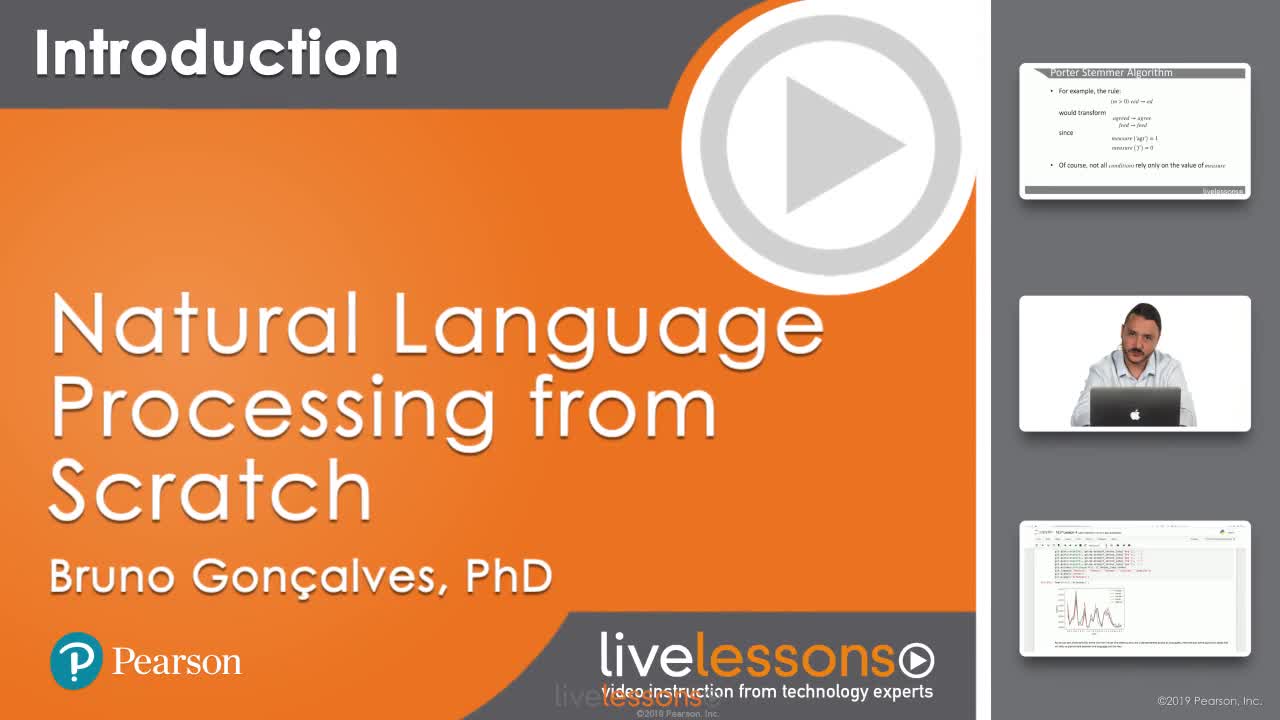Natural Language Processing LiveLessons
- By Bruno Goncalves
- Published Nov 19, 2021 by Addison-Wesley Professional. Part of the LiveLessons series.
Online Video
- Sorry, this book is no longer in print.
- About this video
Video accessible from your Account page after purchase.
Register your product to gain access to bonus material or receive a coupon.
Description
- Copyright 2019
- Edition: 1st
- Online Video
- ISBN-10: 0-13-525885-5
- ISBN-13: 978-0-13-525885-9
2+ Hours of Video Instruction
Overview
Natural Language Processing LiveLessons covers the fundamentals of natural language processing (NLP). It introduces you to the basic concepts, ideas, and algorithms necessary to develop your own NLP applications in a step-by-step and intuitive fashion. The lessons follow a gradual progression, from the more specific to the more abstract, taking you from the very basics to some of the most recent and sophisticated algorithms.
About the Instructor
Bruno Gonçalves is a senior data scientist in the area of complex systems, human behavior, and finance. He has been programming in Python since 2005. For the past five years, his work has focused on NLP and computational linguistics applications on social media. Find out more about Bruno and his work at www.bgoncalves.com.
Skill Level
- Intermediate
Learn How To
- Represent text
- Model topics
- Conduct sentiment analysis
- Understand word2vec word embeddings
- Define GloVe
- Apply language detection
Who Should Take This Course
Data scientists with an interest in natural language processing
Course Requirements
- Basic algebra
- Calculus and statistics
- Programming experience
Lesson Descriptions
Lesson 1: Text Representations
The first step in any NLP application is to establish the representations of text and numbers. One-hot encodings provide us with a sparse approach to representing words and n-grams, while bag-of-words improves memory efficiency even further. Naturally, not all words are meaningful, so the next steps are to remove meaningless stop words and to identify the most relevant words for our application using term frequency/inverse document frequency (TF/IDF). Finally, the lesson covers how to identify the stems of words so you can meaningfully reduce the size of your vocabulary.
Lesson 2: Topic Modeling
Lesson 2 builds on the text representations of Lesson 1 to develop ways of identifying the main subject or subjects of a text. Bruno starts by defining topics and how they can be identified. Next, you learn how to perform explicit semantic analysis to find documents mentioning a specific topic and how to cluster documents according to topics. Latent semantic analysis provides yet another powerful way to extract meaning from raw text, while non-negative matrix factorization enables you to identify latent dimensions in the text, perform recommendations, and measure similarities.
Lesson 3: Sentiment Analysis
After covering how to represent text in a meaningful way and identifying the topics covered in a document, we now focus on how to extract sentiment information. In other words, what kind of sentiments are being expressed? Are the words used positive or negative? The next step is to consider corpus-based approaches to defining the valence of each word and, finally, how to handle negations and modifiers.
Lesson 4: Applications
The first three lessons covered the fundamental tools of NLP, and now you are ready to consider specific applications and advanced topics. Perhaps one of the most important developments in NLP in recent years is the popularization of word embeddings in general and word2vec in particular. This enables you to delve deeper into vector representations of words and concepts, and to understand how semantic relations can be expressed through vector algebra. GloVe is the main competitor to word2vec, and this lesson also explores its advantages and disadvantages. As the final application of NLP and the last section in our course, we consider the question of language detection.
About Pearson Video Training
Pearson publishes expert-led video tutorials covering a wide selection of technology topics designed to teach you the skills you need to succeed. These professional and personal technology videos feature world-leading author instructors published by your trusted technology brands: Addison-Wesley, Cisco Press, Pearson IT Certification, Prentice Hall, Sams, and Que Topics include: IT Certification, Network Security, Cisco Technology, Programming, Web Development, Mobile Development, and more. Learn more about Pearson Video training at http://www.informit.com/video.
Sample Content
Table of Contents
Introduction
Lesson 1: Text Representations
Learning objectives
1.1 Represent words and numbers
1.2 Use one-hot encoding
1.3 Implement bag-of-words
1.4 Apply stop words
1.5 Understand TF/IDF
1.6 Understand stemming
Lesson 2: Topic Modeling
Learning objectives
2.1 Find topics in documents
2.2 Perform explicit semantic analysis
2.3 Implement document clustering
2.4 Implement Latent Semantic Analysis
2.5 Understand non-negative matrix factorization
Lesson 3: Sentiment Analysis
Learning objectives
3.1 Quantify words and feelings
3.2 Use negations and modifiers
3.3 Use corpus-based approaches
Lesson 4: Applications
Learning objectives
4.1 Understand word2vec word embeddings
4.2 Define GloVe
4.3 Apply language detection
Summary More Information

